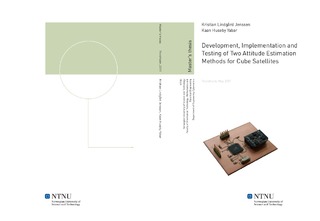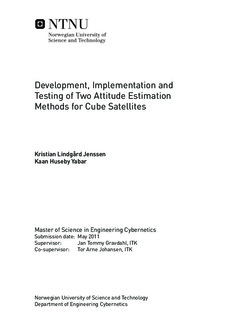| dc.contributor.advisor | Gravdahl, Jan Tommy | nb_NO |
| dc.contributor.advisor | Johansen, Tor Arne | nb_NO |
| dc.contributor.author | Jenssen, Kristian Lindgård | nb_NO |
| dc.contributor.author | Yabar, Kaan Huseby | nb_NO |
| dc.date.accessioned | 2014-12-19T14:03:44Z | |
| dc.date.available | 2014-12-19T14:03:44Z | |
| dc.date.created | 2011-08-24 | nb_NO |
| dc.date.issued | 2011 | nb_NO |
| dc.identifier | 436732 | nb_NO |
| dc.identifier | ntnudaim:5925 | nb_NO |
| dc.identifier.uri | http://hdl.handle.net/11250/260372 | |
| dc.description.abstract | As a part of the CUBESAT project at the Norwegian University ofScience and Technology (NTNU), this paper studies development andcomparison of attitude estimation methods for small cube satellites usinglow-cost sensors. The algorithms are based on data from two vectorizedmeasurements as well as a gyroscope.In this paper a new method for attitude estimation has been de-veloped based on QUaternion ESTimation (QUEST). A major concernwith QUEST is that it cannot handle non-vectorized measurements suchas gyroscope data. Substantial improvements have been made to fusevectorized and non-vectorized measurements, making the new ExtendedQUaternion ESTimation (EQUEST) more suitable for attitude estima-tion. The well known Extended Kalman Filter (EKF) is derived andimplemented for comparison. Both methods have been developed andsimulated in MATLAB. The code have been rewritten using C language.The methods are compared both theoretically and experimentally withimplementation and testing on an AVR microcontroller. Minimum powerusage and number of arithmetic operations were considered during thesoftware development.Testing indicates that the EKF provides a smoother estimation thanthe newly developed EQUEST. In contrast to EQUEST, the EKF isable to estimate the magnetometer and accelerometer bias. However, theEQUEST has a signicantly faster settling time and is less computationalcostly. Compared to the EKF, EQUEST runs more than 5 times faster.It also requires only 8% of the arithmetic operations of the EKF. Anotherdisadvantage with the EKF is tracking problems that occur when the twovectorized measurements are close to parallel. With vectors close to paral-lel, the mathematical formulation of the EKF makes tracking of a rotationaround the parallel axis extremely dicult. These diculties are hardlyobserved in the EQUEST algorithm, which makes it very attractive forattitude estimation.The attitude control of CUBESATs is often done by magnetorquers,which will aect the local magnetic eld. Hence, control and estimationshould not be done simultaneously, resulting in the estimation and controlswitching on and o. For this reason, the long settling time of the EKFmakes the EQUEST even more attractive.The results in this paper indicate that the newly developed EQUESTis highly suitable for projects with either limited budget, space, weight orcomputational power. | nb_NO |
| dc.language | eng | nb_NO |
| dc.publisher | Institutt for teknisk kybernetikk | nb_NO |
| dc.subject | ntnudaim:5925 | no_NO |
| dc.subject | MTTK teknisk kybernetikk | no_NO |
| dc.subject | Reguleringsteknikk | no_NO |
| dc.title | Development, Implementation and Testing of Two Attitude Estimation Methods for Cube Satellites | nb_NO |
| dc.type | Master thesis | nb_NO |
| dc.source.pagenumber | 119 | nb_NO |
| dc.contributor.department | Norges teknisk-naturvitenskapelige universitet, Fakultet for informasjonsteknologi, matematikk og elektroteknikk, Institutt for teknisk kybernetikk | nb_NO |

